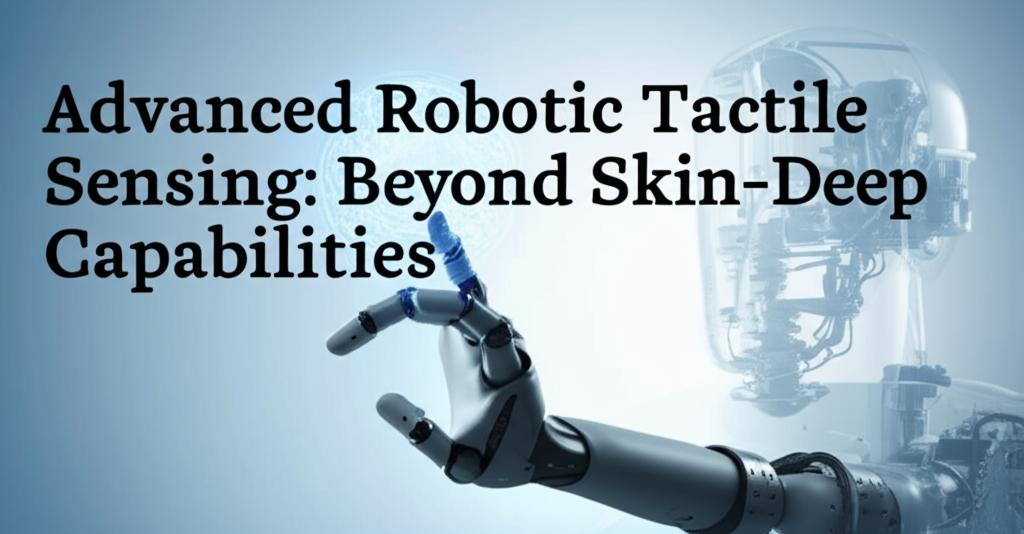Robotic tactile sensing is rapidly evolving beyond simple surface-level contact detection, venturing into a realm of sophisticated capabilities that mimic and even exceed human touch. These cutting-edge advancements are paving the way for robots that can interact with their environment with unprecedented dexterity, sensitivity, and understanding.
Moving Beyond Basic Contact: The Rise of Multi-Modal SensingA key thrust in advanced tactile sensing is the development of multi-modal sensors. These sensors are engineered to perceive a rich tapestry of physical information simultaneously, much like human skin. This includes not just pressure, but also temperature, texture, material thermal properties, slippage, and even forces as minute as a millinewton.
For instance, recent breakthroughs include flexible tactile sensors utilizing thin-film thermistors that can discern a wide array of these properties. Researchers are also exploring triboelectric nanogenerator (TENG)-based sensors capable of detecting both pressure and temperature, even in extreme environments. These multi-modal capabilities are crucial for robots to perform complex manipulation tasks, such as handling delicate, soft, or slippery objects with finesse.
Inspired by Biology, Enhanced by AIMany of these advanced tactile sensors draw inspiration from biological systems, mimicking the microstructures and sensory mechanisms found in human skin. This biomimetic approach aims to replicate the high sensitivity, rapid response, and nuanced perception of natural touch.
Furthermore, the integration of Artificial Intelligence (AI) and machine learning is proving to be a game-changer. AI algorithms can process the vast amounts of data generated by these sophisticated sensors, enabling robots to learn, adapt, and make intelligent decisions based on tactile feedback. For example, machine learning can help sensors adjust to temperature variations in real-time, ensuring consistent and precise performance. AI also plays a crucial role in fusing tactile data with other sensory inputs, like vision, to create a more holistic and human-like perception of the environment.
Key Technological Strides and PlatformsSeveral notable advancements are pushing the boundaries of robotic touch:
- High-Resolution Fingertips: Companies and research institutions are developing artificial fingertips with human-level, and in some cases, superhuman tactile sensing. The Digit 360, a collaboration between Meta AI and GelSight, is a prime example. This fingertip-shaped sensor boasts over 18 sensing features and can detect minute changes in spatial details and capture extremely small forces. Its optical lens can discern imprints around the entire artificial fingertip, providing rich, detailed tactile data.
- Standardized Platforms: To accelerate research and development, standardized hardware-software platforms are emerging. Meta's Digit Plexus, for example, provides a solution for integrating various tactile sensors across a robotic hand, streamlining data collection, control, and analysis. This facilitates easier experimentation and fosters a more open ecosystem for AI and robotics research.
- Tactile-Visual Fusion: A significant area of development is the fusion of tactile sensing with vision. This combination allows robots to overcome the limitations of relying on a single sense. For tasks where vision alone is insufficient (e.g., distinguishing between objects with similar appearances but different textures), tactile input provides critical disambiguating information. Tactile-visual fusion architectures are being developed to seamlessly integrate these sensory modalities from the lowest signal level to the highest levels of robotic decision-making.
- Enhanced Dexterity and Manipulation: The ultimate goal of advanced tactile sensing is to imbue robots with greater dexterity. This means robots that can not only grasp objects securely but also manipulate them with skill and precision, adapting their grip and movements based on real-time tactile feedback. This is crucial for applications ranging from delicate surgical procedures to complex assembly tasks in manufacturing.
- Improved Human-Robot Interaction: As robots become more prevalent in our daily lives, the ability to interact safely and intuitively with humans is paramount. Advanced tactile sensing allows robots to sense and respond to human touch, paving the way for more natural and collaborative human-robot interactions.
Despite significant progress, challenges remain. Scalability of large sensor arrays, reducing crosstalk and latency, and achieving robust multimodal fusion are ongoing areas of research. Furthermore, enabling robots to actively explore environments using touch, akin to human exploratory procedures, is a complex undertaking.
However, the trajectory is clear. The convergence of novel sensor materials, biomimetic designs, sophisticated AI, and integrated platforms is rapidly advancing robotic tactile sensing. We are moving towards a future where robots will not just "see" or "hear" their environment but will also "feel" it with a level of detail and understanding that unlocks a vast array of new applications across industries like healthcare, manufacturing, logistics, prosthetics, and even virtual reality. The continued development of these beyond-skin-deep capabilities promises a new era of intelligent, dexterous, and highly capable robots.

